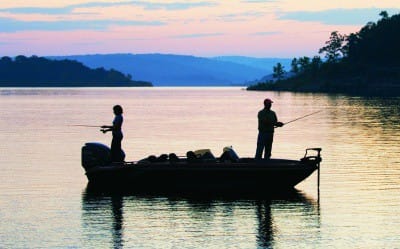
Bass tournament season will shift into high gear later this month. Rare is it in this day that pros get a chance to wet a line in a body of water that they have never fished before, though that could change with the tournament stop at Lake Amistad on the Texas-Mexico border. Many of the pros have never ventured into this deep, steep-banked impoundment that is known to have some very big fish and are now in the same position many of you find yourselves in on a regular basis: on the verge of fishing a lake that they know nothing about.
Hiring a guide is not an option come tournament time, and the same bodes true for a lot of people whose budget just doesn’t allow for the added expense. Left to fend for yourself, there’s a few tried-and-true tricks that can make your first trip to a lake more successful and efficient.
First of all, get a good map of the lake. There are even lake maps on CD that you can use on your computer. Even an old map from the local marina can be a good start. Lake maps can help you locate some general fishing areas, as well as advising you of potentially dangerous rock bars and stump fields. Also, scour the Internet: there’s sure to be a message board for the area you are going to fish where locals and out-of-towners alike will be posting where and what they’re biting. And don’t be afraid to ask other people at the marina and boat ramp.
If you are like me and bass is the species you are after, the first place that I always look is the classic spots. Deep, rocky points, humps and bars will probably have a resident population of ready-to-eat fish. If you can find some trees that have fallen into water that’s deeper than five feet, there’s a good chance that the area is holding fish – especially if the area offers quick and easy access for the fish to reach deep water.
Once you’ve found your area, set some limits for yourself. Even if you think the fishing might be better 30 miles away, limit yourself to the reasonably sized area that offers the characteristics you are looking for. It is much easier to manage your fishing in a pond-sized area than if you are trying to cover 50,000 acres of lake.
If your chosen spot has some weedbeds that grow below the surface, start with a spinnerbait or buzzbait on some medium heavy tackle. By doing this, you are trying to entice those fish that hang out on the edges of the vegetation to feed. If the weedbeds are deeper, try a shallow-running crankbait like a Berkley Frenzy. These baits, in addition to enticing strikes, allow you to cover a lot of area quickly to determine the presence and behavior of the fish. If you find an area with more trees and stumps than vegetation and the bass aren’t responding to the quickly retrieved buzz, spinner and crankbaits, slow down your presentation with a jig and trailer or a Texas-rigged soft plastic like Berkley PowerBait. And don’t give up on a bait too quickly, otherwise you will set yourself into a pattern of switching rigs every other cast. Just like running to different spots on the lake every 15 minutes makes for a frustrating day on the water.
Being able to size up a body of water in a short amount of time under varied conditions is what makes or breaks a professional angler. It takes practice and patience so don’t expect to fill your livewell with a bushel basket full of 8- and 10-pounders the first time out. But if you pay attention and take the time to record some simple notes for yourself, your next trips are bound to be even better.
Ken Cook is the 1991 Bassmaster Classic winner and a 14-time Classic qualifier. A former fisheries biologist, Cook lives on his ranch in Meers, Okla.







